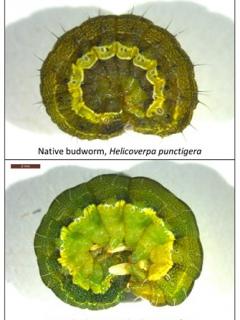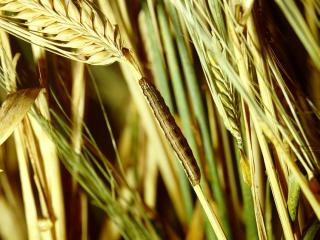Caterpillars in cereal crops: armyworm or budworm?
Recently there have been reports of caterpillars being found in cereal crops. Growers and consultants are reminded that although armyworm are common pests of cereals another caterpillar, native budworm, has also been found chewing on wheat plants in recent years and it is important to be able to distinguish between these species.
In 2020 there were numerous reports of native budworm being found in wheat, with most reports coming from the northern agricultural region (see the PestFax map below).
Caterpillar specimens from some of these wheat crops were submitted to DPIRD diagnostic labs for DNA testing. It was confirmed that native budworm, Helicoverpa punctigera, were in fact feeding on wheat. This was surprising as they traditionally prefer pulse and canola crops.
As part of a GRDC project investigating native budworm feeding on wheat crops, DPIRD are surveying focus crops throughout the Geraldton port zone during 2021 and 2022. Pheremone moth traps have been set up to capture native budworm since early June at 16 focus sites in the region. These traps have been monitored by Rachel Mason (Mingenew Irwin Group) and DPIRD staff. Interestingly native budworm moths have been trapped at all sites. The number of moths captured has ranged from low numbers to over 100 in a fortnight for some sites. Fortunately, native budworm caterpillars have only been detected in low numbers (up to one caterpillar per 100 sweeps) at a few sites.
As we head into spring, growers and consultants are encouraged to send reports of suspect budworm in wheat crops to the DPIRD PestFax service for identification and possible follow-up by DPIRD staff to assess caterpillar numbers and levels of damage.
Lesser budworm
In Western Australia, the most common types of caterpillars which damage cereal crops during winter or spring are lesser budworm (Heliothis punctifera) and armyworms (multiple species). Although some corn earworm (Helicoverpa armigera) moths were detected in pheromone traps in 2017, the caterpillars have never been formally confirmed in cereal crops in WA.

Lesser budworm (which is known to attack cereal crops) caterpillars can be distinguished from native budworm caterpillars by comparing the colour of the hairs along their bodies. Lesser budworm caterpillars have white hairs while native budworm have black hairs (see image above).
Pesticide options for controlling caterpillars can be found in DPIRD’s 2021 winter spring insecticide guide.
For more information refer to DPIRD’s Diagnosing armyworm and Management and economic thresholds for native budworm.
For more information contact Research Scientist Dustin Severtson, Northam on +61 (0)8 9690 2160 or Technical Officer Alan Lord, South Perth on +61 (0)8 9368 3758.
Article author: Dustin Severtson (DPIRD Northam).

